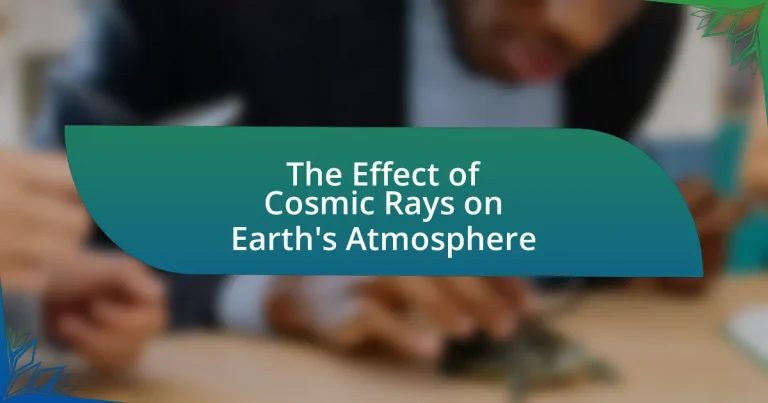Cosmic rays are high-energy particles from outer space that interact with Earth’s atmosphere, leading to the production of secondary particles and influencing atmospheric chemistry and climate. This article explores the origins of cosmic rays, primarily from supernovae and solar flares, and their significant role in cloud formation, ozone depletion, and potential impacts on climate variability. Additionally, it examines the biological effects of cosmic rays on living organisms, including increased cancer risks and genetic mutations, as well as protective mechanisms that organisms have developed. The article also discusses practical measures for monitoring and mitigating the effects of cosmic rays on sensitive ecosystems and human health.
What are Cosmic Rays and How Do They Interact with Earth’s Atmosphere?
Cosmic rays are high-energy particles originating from outer space, primarily consisting of protons, atomic nuclei, and electrons. When these cosmic rays enter Earth’s atmosphere, they collide with air molecules, leading to a cascade of secondary particles, including muons, pions, and gamma rays. This interaction occurs at altitudes of about 15 to 30 kilometers, where the density of the atmosphere is sufficient to facilitate these collisions. Studies have shown that cosmic rays contribute to the ionization of the atmosphere, which can influence cloud formation and potentially affect climate patterns. For instance, research published in the journal “Nature” by Svensmark et al. (2007) indicates a correlation between cosmic ray activity and cloud cover variations, suggesting that cosmic rays may play a role in Earth’s climate system.
What are the sources of Cosmic Rays?
Cosmic rays originate primarily from supernova explosions, active galactic nuclei, and solar flares. Supernovae are stellar explosions that release vast amounts of energy, accelerating particles to high speeds, which then travel through space. Active galactic nuclei, particularly those associated with supermassive black holes, emit high-energy particles as well. Solar flares, which are bursts of radiation from the sun, also contribute to the cosmic ray population, especially during periods of heightened solar activity. These sources collectively account for the majority of cosmic rays detected on Earth, with supernovae being the most significant contributors, as evidenced by their role in the production of high-energy protons and heavier nuclei.
How do solar and galactic sources differ in their contributions?
Solar and galactic sources differ significantly in their contributions to cosmic rays impacting Earth’s atmosphere. Solar cosmic rays primarily originate from the Sun, particularly during solar flares and coronal mass ejections, contributing to a relatively lower intensity of cosmic rays that reach Earth, typically around 10% of the total cosmic ray flux. In contrast, galactic cosmic rays, which come from outside the solar system, are more energetic and account for approximately 90% of the cosmic rays that interact with Earth’s atmosphere. These galactic sources include high-energy particles from supernovae and other astrophysical phenomena, leading to a greater impact on atmospheric chemistry and climate. The distinction in their contributions is crucial for understanding the overall effects of cosmic rays on Earth’s atmosphere, including cloud formation and potential climate variability.
What role do supernovae play in cosmic ray production?
Supernovae are significant sources of cosmic ray production, contributing to the acceleration of high-energy particles in the universe. When a massive star explodes as a supernova, it releases an enormous amount of energy, creating shock waves that can accelerate protons and heavier nuclei to relativistic speeds. This process is supported by observations indicating that supernova remnants are sites of cosmic ray acceleration, with estimates suggesting that they may account for up to 90% of the cosmic rays observed in the galaxy.
How do Cosmic Rays penetrate the Earth’s atmosphere?
Cosmic rays penetrate the Earth’s atmosphere primarily through their high energy, which allows them to overcome the atmospheric particles and electromagnetic fields. These high-energy particles, mostly protons and atomic nuclei, travel at nearly the speed of light and can collide with air molecules, resulting in a cascade of secondary particles. This process, known as an extensive air shower, occurs when cosmic rays interact with the atmosphere, producing a variety of secondary particles, including muons and neutrinos, which can reach the Earth’s surface. Studies have shown that approximately 90% of cosmic rays are deflected or absorbed by the atmosphere, but the remaining particles can still reach the ground, contributing to background radiation levels.
What physical processes allow Cosmic Rays to reach the surface?
Cosmic rays reach the Earth’s surface primarily through a series of interactions with the atmosphere, including ionization, scattering, and nuclear reactions. When cosmic rays, which are high-energy particles originating from outer space, enter the Earth’s atmosphere, they collide with air molecules, leading to ionization and the production of secondary particles. These secondary particles can further interact with other atmospheric constituents, creating a cascade of reactions known as an extensive air shower.
As these interactions occur, some of the secondary particles, such as muons, can penetrate deeper into the atmosphere and eventually reach the surface. Studies have shown that muons, which are produced in these cascades, can travel through several kilometers of air and still maintain enough energy to reach the ground. For instance, approximately 1 muon per square meter per minute reaches the Earth’s surface, demonstrating the effectiveness of these physical processes in allowing cosmic rays to impact the surface.
How does the Earth’s magnetic field influence Cosmic Ray trajectories?
The Earth’s magnetic field influences cosmic ray trajectories by deflecting charged particles, which are primarily protons and atomic nuclei. This deflection occurs due to the Lorentz force, which acts on charged particles moving through a magnetic field, causing them to follow curved paths rather than straight lines. As a result, cosmic rays originating from outside the solar system are partially shielded by the Earth’s magnetic field, leading to a variation in their intensity at the surface. Studies have shown that the geomagnetic field strength varies with latitude, affecting the penetration depth of cosmic rays; for instance, cosmic ray intensity is higher at the poles compared to the equator due to the weaker magnetic field in those regions.
What are the effects of Cosmic Rays on atmospheric chemistry?
Cosmic rays significantly influence atmospheric chemistry by ionizing molecules in the atmosphere, leading to the formation of secondary particles and reactive species. This ionization process can initiate chemical reactions that produce ozone and other trace gases, which play critical roles in atmospheric processes and climate regulation. Studies have shown that cosmic rays contribute to the production of nitrogen oxides, which can affect ozone levels and influence cloud formation. For instance, research published in the journal “Atmospheric Chemistry and Physics” by authors such as J. A. McCoy and colleagues highlights the correlation between cosmic ray intensity and variations in atmospheric composition, demonstrating their impact on both local and global scales.
How do Cosmic Rays contribute to the formation of clouds?
Cosmic rays contribute to the formation of clouds by ionizing particles in the atmosphere, which facilitates the condensation of water vapor into cloud droplets. When cosmic rays collide with molecules in the atmosphere, they produce secondary particles and ions that serve as nucleation sites for cloud condensation. Research indicates that increased cosmic ray activity correlates with higher cloud cover, as demonstrated in a study by Svensmark and Friis-Christensen, which found a link between cosmic ray intensity and low cloud formation over several decades. This process highlights the significant role cosmic rays play in influencing cloud microphysics and, consequently, climate patterns.
What impact do Cosmic Rays have on ozone depletion?
Cosmic rays contribute to ozone depletion by initiating chemical reactions in the atmosphere that lead to the breakdown of ozone molecules. When cosmic rays collide with atmospheric particles, they produce secondary particles and radiation that can catalyze reactions involving ozone-depleting substances. Research indicates that these interactions can enhance the formation of reactive nitrogen species, which are known to destroy ozone. For instance, studies have shown that increased cosmic ray activity correlates with fluctuations in ozone levels, particularly in the stratosphere, where the ozone layer is located.

What are the Biological Effects of Cosmic Rays on Earth?
Cosmic rays can cause biological effects on Earth primarily through ionization, which can damage DNA and lead to mutations. These high-energy particles, originating from outer space, interact with the Earth’s atmosphere and produce secondary particles that can penetrate living organisms. Research indicates that exposure to cosmic rays is linked to increased cancer risk due to the potential for genetic mutations. For instance, studies have shown that astronauts, who are exposed to higher levels of cosmic radiation, exhibit a greater incidence of certain cancers compared to the general population. Additionally, cosmic rays can affect cellular processes and immune responses, further impacting health.
How do Cosmic Rays affect living organisms?
Cosmic rays affect living organisms primarily through their ionizing radiation, which can damage cellular structures and DNA. This radiation can lead to mutations, increased cancer risk, and other health issues in organisms exposed to high levels of cosmic rays, particularly at high altitudes or in space. Studies have shown that astronauts experience higher rates of certain cancers due to prolonged exposure to cosmic rays, as evidenced by research published in the journal “Radiation Research” by authors such as C. J. H. Horneck and others, which highlights the biological effects of space radiation on human health.
What are the potential health risks associated with Cosmic Ray exposure?
Cosmic ray exposure poses several potential health risks, primarily due to the ionizing radiation they emit. This radiation can lead to increased cancer risk, particularly for astronauts and airline crew members who are exposed to higher levels at high altitudes. Studies indicate that cosmic rays can damage DNA, leading to mutations that may result in cancer. For instance, the National Council on Radiation Protection and Measurements (NCRP) has reported that the risk of cancer increases with cumulative radiation exposure, including from cosmic rays. Additionally, cosmic rays can cause acute radiation sickness at extremely high doses, although such levels are rare in typical exposure scenarios.
How do Cosmic Rays influence genetic mutations in organisms?
Cosmic rays influence genetic mutations in organisms primarily through the ionization of atoms in biological tissues, leading to DNA damage. When cosmic rays, which are high-energy particles from outer space, collide with atoms in the atmosphere or on Earth, they produce secondary particles that can penetrate living organisms. This interaction can result in single or double-strand breaks in DNA, which, if not properly repaired, can lead to mutations. Research has shown that exposure to cosmic radiation can increase mutation rates in various organisms, including bacteria and plants, as evidenced by studies such as those conducted by the European Space Agency, which found that ionizing radiation from cosmic rays can significantly impact genetic stability.
What protective mechanisms do organisms have against Cosmic Rays?
Organisms have several protective mechanisms against cosmic rays, primarily through biological and physical adaptations. For instance, many organisms possess DNA repair systems that can correct damage caused by radiation exposure, such as the nucleotide excision repair pathway, which is crucial for repairing DNA lesions. Additionally, some species produce antioxidants that mitigate oxidative stress induced by radiation, helping to protect cellular components from damage. Furthermore, organisms that live underground or in dense environments benefit from physical shielding provided by soil or rock, which reduces cosmic ray exposure. These mechanisms collectively enhance survival and cellular integrity in environments subjected to cosmic radiation.
How does the Earth’s atmosphere shield life from Cosmic Rays?
The Earth’s atmosphere shields life from cosmic rays primarily through its composition and density, which absorb and scatter high-energy particles. The atmosphere consists of layers of gases, including nitrogen and oxygen, that interact with cosmic rays, reducing their intensity before they reach the surface. Approximately 90% of cosmic rays are absorbed or deflected by the atmosphere, with the remaining particles losing energy through collisions with atmospheric molecules. This protective mechanism is crucial for maintaining the safety of living organisms, as cosmic rays can cause cellular damage and increase cancer risk.
What adaptations have evolved in species exposed to higher radiation levels?
Species exposed to higher radiation levels have evolved several adaptations, including enhanced DNA repair mechanisms, increased antioxidant production, and altered reproductive strategies. For instance, certain microorganisms, such as Deinococcus radiodurans, possess exceptional DNA repair capabilities that allow them to survive extreme radiation by efficiently repairing double-strand breaks in their DNA. Additionally, some plants and animals have developed increased levels of antioxidants, which help mitigate oxidative stress caused by radiation exposure. These adaptations enable these species to thrive in environments with elevated radiation, demonstrating their resilience and evolutionary response to such extreme conditions.

What are the Implications of Cosmic Rays for Climate and Weather Patterns?
Cosmic rays have significant implications for climate and weather patterns by influencing cloud formation and atmospheric chemistry. Research indicates that cosmic rays can enhance the nucleation of cloud droplets, which may lead to increased cloud cover and potentially affect Earth’s climate. A study published in the journal “Atmospheric Chemistry and Physics” by Svensmark et al. (2016) demonstrated that variations in cosmic ray intensity correlate with changes in cloud cover, suggesting a link between cosmic rays and climate variability. Additionally, cosmic rays can affect the production of aerosols, which play a crucial role in climate regulation by influencing the Earth’s radiation balance.
How do Cosmic Rays influence climate change?
Cosmic rays influence climate change primarily by affecting cloud formation in the Earth’s atmosphere. When cosmic rays collide with molecules in the atmosphere, they produce secondary particles that can act as nucleation sites for cloud condensation. This process can lead to an increase in cloud cover, which in turn affects the Earth’s climate by altering the balance of solar radiation that reaches the surface. Research indicates that variations in cosmic ray intensity correlate with changes in cloud cover and, consequently, climate patterns. For example, a study published in the journal “Atmospheric Chemistry and Physics” by Svensmark and Friis-Christensen in 1997 suggested that increased cosmic ray activity could lead to cooler temperatures due to enhanced cloud formation.
What is the relationship between Cosmic Rays and cloud formation?
Cosmic rays influence cloud formation by ionizing particles in the atmosphere, which can enhance the nucleation of cloud droplets. Research indicates that increased cosmic ray activity correlates with higher cloud cover, as demonstrated in a study by Svensmark et al. (2009), which found that cosmic rays can lead to increased ionization, promoting the formation of aerosols that serve as cloud condensation nuclei. This relationship suggests that variations in cosmic ray intensity may impact climate by altering cloud properties and coverage.
How might Cosmic Rays affect global temperature trends?
Cosmic rays may influence global temperature trends by affecting cloud formation and, consequently, climate patterns. Research indicates that increased cosmic ray activity can lead to higher cloud cover, which can reflect sunlight and potentially cool the Earth’s surface. A study published in the journal “Environmental Research Letters” by Svensmark and colleagues in 2016 found a correlation between cosmic ray intensity and cloud formation, suggesting that variations in cosmic rays could contribute to climate variability. This relationship implies that fluctuations in cosmic ray levels might play a role in modulating global temperatures over time.
What are the potential impacts of Cosmic Rays on weather systems?
Cosmic rays can influence weather systems by affecting cloud formation and atmospheric ionization. Research indicates that cosmic rays contribute to the nucleation of cloud droplets, which can enhance cloud cover and precipitation patterns. A study published in the journal “Atmospheric Chemistry and Physics” by Svensmark and Friis-Christensen in 1997 demonstrated a correlation between cosmic ray intensity and low cloud cover, suggesting that variations in cosmic ray flux may impact climate and weather variability. Additionally, cosmic rays can alter the electrical properties of the atmosphere, potentially influencing storm development and intensity.
How do Cosmic Rays interact with atmospheric phenomena like storms?
Cosmic rays interact with atmospheric phenomena like storms primarily through ionization processes. When cosmic rays, which are high-energy particles originating from outer space, enter the Earth’s atmosphere, they collide with air molecules, leading to the production of secondary particles and ionization. This ionization can influence cloud formation and precipitation by affecting the electrical properties of the atmosphere. Studies have shown that increased cosmic ray activity correlates with enhanced cloud condensation nuclei, which can lead to more extensive cloud cover and potentially influence storm development. For instance, research published in the journal “Atmospheric Chemistry and Physics” by authors such as Kirkby et al. (2011) indicates that cosmic rays can modulate cloud microphysics, thereby impacting weather patterns and storm intensity.
What role do Cosmic Rays play in precipitation patterns?
Cosmic rays influence precipitation patterns by affecting cloud formation and atmospheric processes. When cosmic rays enter the Earth’s atmosphere, they can ionize air molecules, leading to the formation of aerosols, which serve as cloud condensation nuclei. This process can enhance cloud formation and potentially increase precipitation. Research by Svensmark et al. (2016) indicates that variations in cosmic ray intensity correlate with changes in cloud cover and precipitation patterns, suggesting a link between cosmic rays and climate variability.
What practical measures can be taken to mitigate the effects of Cosmic Rays?
To mitigate the effects of cosmic rays, practical measures include enhancing shielding in spacecraft and high-altitude flights, as well as implementing monitoring systems for radiation exposure. Spacecraft can be designed with materials such as polyethylene or water, which are effective at absorbing cosmic radiation, thereby reducing the dose received by astronauts. High-altitude flights can be rerouted or scheduled at lower altitudes during periods of increased solar activity, which can elevate cosmic ray levels. Additionally, real-time monitoring of radiation levels allows for timely adjustments to flight paths or operational protocols, ensuring safety for both crew and passengers. These measures are supported by research indicating that effective shielding can significantly reduce radiation exposure, as demonstrated in studies conducted by NASA and other space agencies.
How can technology be used to monitor Cosmic Ray levels?
Technology can be used to monitor Cosmic Ray levels through the deployment of ground-based detectors, satellite instruments, and advanced data analysis techniques. Ground-based detectors, such as scintillation counters and cloud chambers, measure the secondary particles produced when cosmic rays interact with the Earth’s atmosphere. Satellite instruments, like the Alpha Magnetic Spectrometer (AMS-02), capture cosmic rays directly in space, providing data on their energy and composition. Additionally, data analysis techniques, including machine learning algorithms, enhance the interpretation of cosmic ray data, allowing for real-time monitoring and improved understanding of cosmic ray variations. These methods collectively contribute to a comprehensive monitoring system for cosmic ray levels, essential for studying their effects on the Earth’s atmosphere and climate.
What strategies can be implemented to protect sensitive ecosystems from Cosmic Ray impacts?
To protect sensitive ecosystems from Cosmic Ray impacts, strategies such as enhancing ecosystem resilience, implementing shielding techniques, and conducting ongoing research are essential. Enhancing ecosystem resilience involves promoting biodiversity and restoring habitats, which can help ecosystems better withstand external stressors, including radiation. Shielding techniques, such as creating physical barriers or utilizing materials that absorb or deflect cosmic rays, can reduce exposure in vulnerable areas. Ongoing research is crucial to understand the specific effects of cosmic rays on various ecosystems, allowing for targeted interventions. Studies have shown that increased biodiversity can enhance ecosystem stability, which supports the effectiveness of these strategies.



